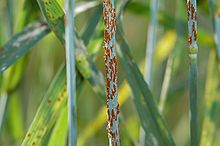User:M G Tuffen/Sandbox
Phytopathogenic fungi are fungi that cause plant diseases. They can generally be divided into two groups, biotrphic fungi that tap into living plant cells in order to gain nutrients and necrotrophic fungi that kill plant cells and consume the nutrients that are released. Fungal plant pathogens are spread by spores that can be both sexual and asexual and may be dispersed by wind and water. Fungal plant pathogens are responsible for many important plant diseases and cause very large yeild losses. Fungal diseases are not to be confused with diseases caused by the fungal like organisms oomycetes. Fungal diseases can be controlled using fungicides.
Taxonomy[edit]

There are over 10 000 species of fungi that can cause disease in plants.[1] Most phytopathogenic fungi belong to the ascomycetes or the basdiomycetes. Some genera like Fusarium, contain both phytpathogenic fungi and non-pathogenic fungi while other genera like Puccinia consist nearly entirely of phytopathogenic species. Within the phytopathogenic fungi there also exsist forma specialis (abbreviated to f. sp.), a taxonomic group within a species of the fungi that is defined by the host it is able to infect.[2] An example is Puccinia graminis, which has several forma specialis each able to cause disease on a different host species. For example, Puccinia graminis f. sp. tritici can will cause stem rust on wheat and Puccinia graminis f. sp. avenae causes the same disease on oat.[3] This is a more appropriate term to use than sub-species, which is normally applied to explain differences in species caused by geographical isolation rather than adaption to a specific host.[4]
Within a species or a forma specialis there will also exsist different races. These races are defined by their virulence, the symptoms they cause or host range.[5] For example Ug99 is an agressive race of Puccinia graminis f. sp. tritici that is able to overcome many resistance genes bred into wheat against stem rust.[6]
Germination and Penetration[edit]
The biology of germenation and penetration of fungal spores will depend upon the manner they are dispersed.
Airborne Spores[edit]
Airborne spores will firstly need to attach to the plant leaf surface, which is initially done through hydrophobic interactions between the spore and the waxy cuticle that covers the leaf surface.[1] In some species the spore will then produce molecules called adhesins that cause irreversable attachment to the plant surface.[7]
Necrotrophs[edit]
Explanation of necrotroph lifestyle
Biotrophs[edit]
Explanation of biotroph lifestyle including haustauria.
Hemibiotrophs[edit]
Oomyctes[edit]
Oomycetes, or water moulds, are fungal like organisms that were once thought to be fungi.[8] This is because they have similar lifestyles, and oomycete plant pathogens use similar mechanisms to infect plants but this is actually an example of convergent evolution.[9] However, because of their similarities, fungicides can also be used to control oomycetes. Examples of oomycete plant diseases include Phytophthora infestans the causal agent of potato late blight and the downy mildews.
Reproduction and Spread[edit]
Like other fungi, phytopathogenic fungi reproduce and spread through the production of spores. There are many different kinds of spores, that are classified both by the kind of fungi that poduced them and their function. In phytopathogenic fungi, most spores are spread by wind or deposited in the soil.
Spore Production[edit]
Asexual and Sexual spores, brielfy on mating types, how two mating types may not always be availible, bad if mating types meet, overwintering
Soil Bourne Spores[edit]
soil bourne spores
Wind bourne spores[edit]
Spore dispersal by wind (examples)
Splash bourne spores[edit]
Spore dispersal by splash (examples)
Control[edit]
Information on how fungal diseases are controlled
Fungicides[edit]
One of the most commons ways of controling fungal infections of plants is the use of fungicides. Fungicides can be preventative, in which case they will stop disease developing and others have curative properties. Fungicides are also classed as contact, staying on the plants surface, or systemic when they are taken up by the plant. Over time, pathogens will develop fungicide resistance by a variety of mechanisms including changing the target protein or upregulating it's production or developing a pathway to detoxify the fungicide. There are recommended practises to avoid the development of fungicide resistance, which include not using a single fungicide in isolation and making sure the correct dosage of the product is used.[10]
Biological Control[edit]
Information on biological control
Other practises[edit]
Information on sanitation and other control practises
Yeild losses[edit]
Information on economic loss and yeild losses caused by fungal diseases
See Also[edit]
External Links[edit]
References[edit]
- ^ a b Dickinson, M (2003). Molecular Plant Pathology. BIOS Scientific Publishers. ISBN 1-85996-044-8.
- ^ D'arcy, C. J. (2001). "Illustrated Glossary of Plant Pathology - defination of forma specialis". APS. Retrieved 2008-03-25.
{{cite web}}: Unknown parameter|coauthors=ignored (|author=suggested) (help) - ^ Leonard, Kurt J.; Szabo, LES J. (2005). "Stem rust of small grains and grasses caused by Puccinia graminis". Molecular Plant Pathology. 6 (2). Blackwells: 99–11. doi:10.1111/j.1364-3703.2005.00273.x. PMID 20565642.
- ^ "Definition of a sub-species". The Biologist. 52 (1). Phi Sigma Society: 46. 1970.
- ^ D'arcy, C. J. (2001). "Illustrated Glossary of Plant Pathology - defination of race". APS. Retrieved 2008-03-25.
{{cite web}}: Unknown parameter|coauthors=ignored (|author=suggested) (help) - ^ Mackenzie, Deborah (2007-01-03). "Billions at risk from wheat super-blight". New Scientist. Retrieved 2008-05-10.
- ^ Braun, E. J.; Howard, R. J. (1994). "Adhesion of fungal spores and germlings to host plant surfaces". Protoplasma. 181 (1–4). Springer: 202–212. doi:10.1007/BF01666396.
- ^ Introduction to Oomycota
- ^ Latijnhouwers, Maita; De Wit, Pierre J.G.M.; Govers, Francine (2003). "Oomycetes and fungi: similar weaponry to attack plants". Trends in Microbiology. 11 (10). Elsevier: 462–469. doi:10.1016/j.tim.2003.08.002. PMID 14557029.
- ^ Fungicide Resistance Action Group
